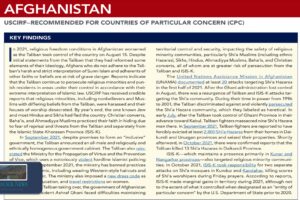Days of August 2021, as the United States undertook a massive evacuation effort from Afghanistan, concerns about national security rose to prominence. Among these concerns was the possibility of ISIS-K sleeper cells infiltrating the U.S. during the evacuation process. A recent report from Kauser News Agency cites sources from Kabul, claiming that these sleeper cells have not only entered the United States but have also started their operations, including attempts to secure financial support for their teams.
The rapid withdrawal of U.S. forces and the Taliban’s swift takeover of Afghanistan created a precarious environment. With the Kabul airport overwhelmed by thousands desperate to flee, the process of vetting evacuees became exceedingly difficult. Despite the best efforts of U.S. and allied intelligence agencies, the sheer volume of evacuees and the chaotic circumstances led to vulnerabilities in the screening process.
The risk of extremists exploiting such a situation was well-known. ISIS-K, or the Islamic State Khorasan Province, a regional affiliate of the Islamic State, had already demonstrated its capability to carry out deadly attacks, including the bombing at Hamid Karzai International Airport that killed over 180 people, including 13 U.S. service members. The organization’s brutal tactics and transnational ambitions make it a significant threat not just in Afghanistan but globally.
According to a source in Kabul cited by Kauser News Agency, ISIS-K operatives successfully infiltrated the U.S. during the evacuation. These sleeper cells reportedly aim to establish themselves within American communities, operating discreetly while laying the groundwork for future activities. Their immediate goals appear to include securing financial resources and building networks to support their operations domestically and abroad.
If true, this development represents a grave threat to U.S. national security. Sleeper cells are designed to remain inactive or inconspicuous for extended periods, blending into society while awaiting orders to act. Their presence in the U.S. could enable a range of activities, from recruitment and fundraising to planning and executing attacks.
Financial Support and Network Building
One of the primary objectives of these alleged sleeper cells is to generate financial support for their teams. Terrorist organizations often rely on a variety of methods to fund their activities, including:
- Charitable Fronts: Establishing or exploiting nonprofit organizations to solicit donations under the guise of humanitarian work.
- Criminal Enterprises: Engaging in illegal activities such as drug trafficking, fraud, or smuggling.
- Community Contributions: Coercing or persuading members of specific communities to contribute financially.
- Online Campaigns: Utilizing social media and other digital platforms to solicit funds anonymously.
ISIS-K’s ability to secure financial resources in the U.S. would not only bolster its operations domestically but also provide critical support to its counterparts abroad, fueling further instability.
U.S. Counter-terrorism Efforts
The U.S. government has long been aware of the threat posed by sleeper cells and has implemented a multi-faceted approach to counter it. Key components of this strategy include:
- Vetting and Screening: Strengthening the processes used to screen refugees and evacuees. Following the 2021 evacuation, efforts were intensified to identify and monitor individuals who may pose a threat.
- Surveillance and Intelligence Gathering: Utilizing advanced technology and human intelligence to detect and monitor suspicious activities. Collaboration with international partners is crucial in tracking the movements and communications of terrorist networks.
- Financial Tracking: Working with financial institutions to identify and disrupt the flow of funds to terrorist organizations. This includes monitoring unusual transactions and freezing assets linked to terrorism.
- Community Engagement: Building trust with communities to encourage reporting of suspicious activities and reduce the risk of radicalization.
Challenges in Countering Sleeper Cells
Despite robust counter-terrorism efforts, addressing the threat of sleeper cells poses unique challenges. These include:
- Stealth and Integration: Sleeper cells are designed to avoid detection, often integrating into society and maintaining low profiles until activated.
- Encryption and Technology: The use of encrypted communication platforms makes it difficult for law enforcement to monitor their activities.
- Resource Limitations: The vast number of potential threats stretches the resources of intelligence and law enforcement agencies.
The infiltration of ISIS-K sleeper cells, if confirmed, underscores the broader implications of the 2021 evacuation and the ongoing threat of terrorism. It highlights the need for:
- Enhanced Refugee Screening: Developing more effective methods to vet individuals without compromising the humanitarian nature of refugee programs.
- International Cooperation: Strengthening global partnerships to address the transnational nature of terrorist threats.
- Public Awareness: Educating communities about the signs of radicalization and the importance of reporting suspicious activities.
The claims of ISIS-K sleeper cells operating in the United States serve as a stark reminder of the complexities and risks associated with large-scale evacuations from conflict zones. While the U.S. continues to adapt and strengthen its counterterrorism strategies, the evolving nature of threats demands vigilance from both the government and the public. Preventing these cells from gaining a foothold is not just a matter of national security but a collective responsibility to ensure the safety and stability of society.





